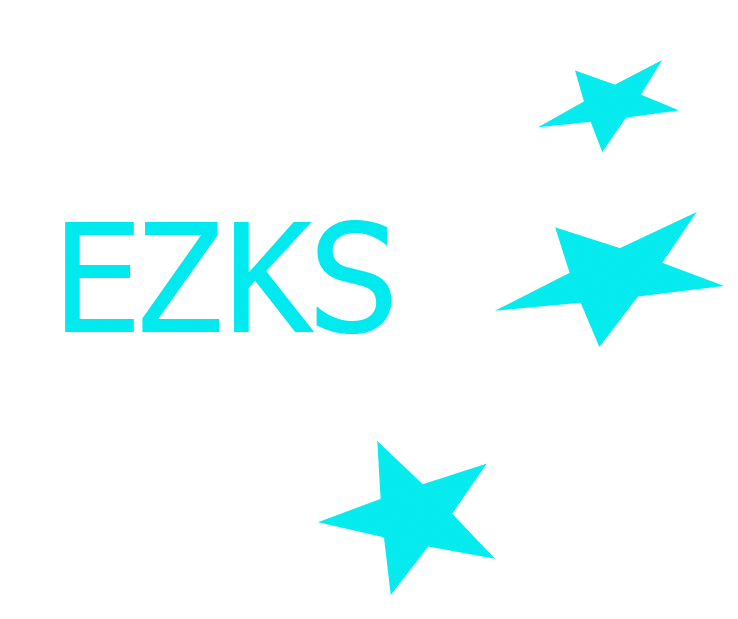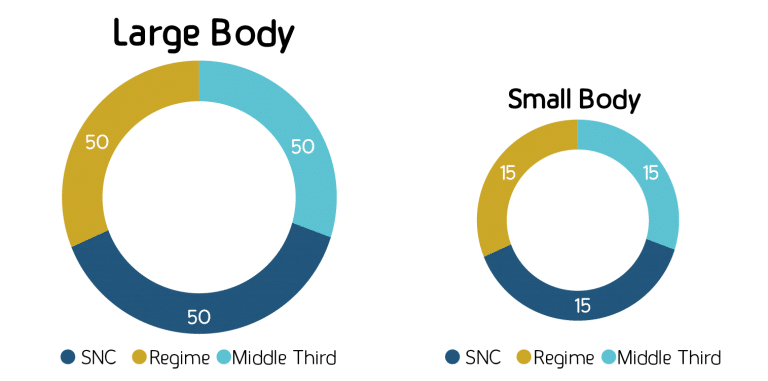What is the Syrian Constitutional Committee?
Timeline of the Syrian Constitutional Committee
How does the SCC work?
The SCC consist of a Large and a Small Body. The Large Body comprises 150 men and women – 50 nominated by the Government; 50 nominated by the oppositional Syrian Negotiations Commission (SNC), and 50 persons belonging to “civil society” and nominated by the UN. The Small Body comprises 45 men and women out of these 150 – 15 nominated by the Government, 15 nominated by the Syrian Negotiations Commission, and 15 from among the civil society block. The task of the Small Body is to prepare and draft the constitutional proposal, the Large Body shall adopt it. Large and Small Body take decisions by consensus where possible but otherwise by voting. It requires the support of a minimum of 75% of members in the respective body.
The SCC has two Co-Chairs – one nominated by the Government of Syria and one nominated by the Syrian Negotiations Commission (SNC). Among other things, their functions include chairing and guiding meetings and sessions, proposing and ensuring observance of rules of procedure and facilitating and proposing an agenda and work-plans.
Who is who?
Composition of the Syrian Constitutional Committee
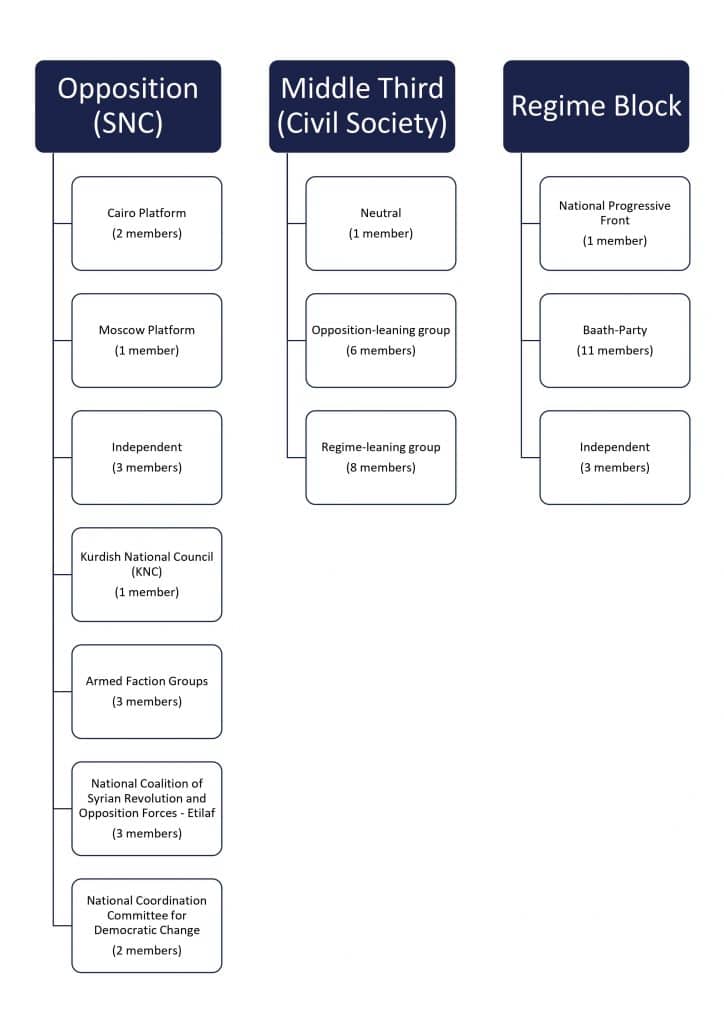
The Opposition – SNC
The Syrian opposition is a complex and heterogeneous network of various activists, politicians and groups calling for an end to the Assad regime. Some of its members were active opposition politicians even before 2011, while other groups only formed after the public protests began. Most of the opposition politicians are living in exile and currently cannot return to Syria due to fear of persecution. Some opposition groups have been trying to form coalitions and alliances since 2011 in order to unite the supporters of the opposition and receive international support and recognition. In the SCC, the Syrian opposition is represented by the Syrian Negotiation Commission (SNC) which is currently the largest opposition alliance. However, the SNC is not a homogenous group, but highly divided when it comes to topics as women’s rights, human rights, minority rights, decentralisation, the role of religion etc.
Hadi Al-Bahra
Dima Moussa
Haytham Rahma
Kamîran Hajo
Safwan Akkash
Ahmed Al-Esrawi
Jamal Soliman
Talid Saieb
Mohannad Dlykan
Hasan Al-Hariri
Hassan Obeid
Mohamad Ahmad
Bassma Kodmani
Awad Alali
Tarek Al-Kurdi
The Middle Third – Civil Society
The Middle Third consists of civil society actors and has formally been appointed by the United Nations. However, the SNC, the Syrian government, but also the governments of Turkey, Saudi Arabia, Russia and Iran influenced the selection of the members of the Middle Third. As a consequence, about 50 % of the Middle Third are said to be regime-leaning, while the other 50% percent are close to the opposition. It is thus extremely difficult for this group to find consensus or to build bridges between government and opposition. Moreover, as the Middle Third has no Co-Chair, its members have no possibility to considerably shape the sessions of the SCC.
Mais Elkrydee
Mousa Metri
Maher Mlandy
Ali Abbas
Isam Zibaq
Sonia Halabi
Samar Al-Dyub
Anas Zrea
Omar Abdulaziz Hallaj
Raghdaa Zidan
Khaled Al-Helo
Sabah Al-Hallak
Mazen Gharibah
Eman Shahoud
Elaf Yassin
The Regime
The SCC members appointed by the Syrian government are mostly state employees. Many of them live in Syria – as a consequence their space to start a meaningful dialogue with members of the opposition or the Middle Third of the SCC is extremely limited. Thus far, the Syrian government has not shown any interest in making the SCC function. The fact that it took from 2015 to 2019 to only establish the Constitutional Committee must be charged to the Syrian government which attempted to change the reality on the ground to its advantage before entering any political dialogue.
Ahmad Farouk Arnous
Mouhammed Issam Hazime
Riad Taouz
Nezar Skef
Amjad Issa
Jamal Kadri
Ashwaq Abbas
Dareen Sleman
Mohamad Khir Alakam
Haissam Altass
Ahmad Al-Kuzbary
Amal Yazji
Abdullah Al-Sayed
Akram Al-Ajlani
Jamila Al-Shurbaji
SCC members introducing themselves
How is the Syrian population represented in the SCC?
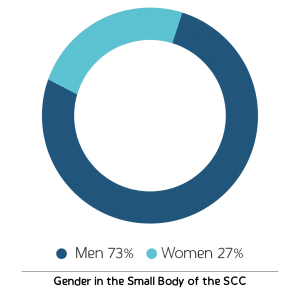
Gender in the Small Body of the SCC
Resolution 2254 is “encouraging the meaningful participation of women in the UN-facilitated political process for Syria.” (UNSCR 2015) The UN Women (Entity for gender and Equality of Women) together with several women-rights organizations and networks demanded a thirty percent quota of women in the SCC and for all negotiating parties. However, neither the opposition (14%) nor the regime (24%) met this requirement. Only the Middle Third exceeded these expectations appointing a share of 40% female members of the SCC. So, in total, 27% of the SCC are female which is still low considering that women make up 53% of the Syrian society. However, the international average percentage for women in parliaments is 24,5%. In detail, this means that the Middle Third has six female members in the Small Body. The Large Body of the Middle Third encompasses another twelve women. In the Small Body of the opposition block, there are only two women (out of fifteen members) represented. Five other women are part of the Large Body of the opposition block. In the regime block of the SCC, there are three women in the Small Body and another seven women in the Large Body.
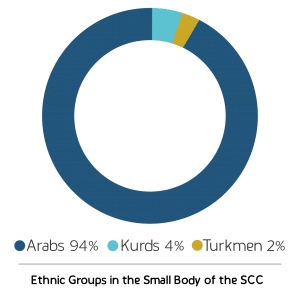
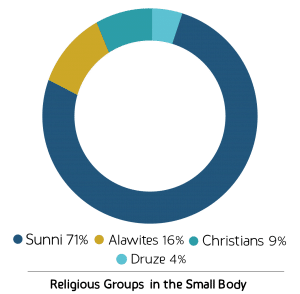
Minorities in the Small Body of the SCC
Even though according to vague estimations around 10–15% of the Syrian population is Kurdish, only six out of 150 members (4%) of the Large Body are of Kurdish origin (two in the opposition block, two in the Middle Third and two in the regime block). In the Small Body, there are two Kurds, one from the regime block and one from the opposition. However, only Kamîran Hajo of the Kurdish National Council (opposition block) understands himself as representative of Kurdish interests.
Not only the Kurds, but also other minorities are underrepresented in the SCC – even though to a lesser degree. With 2%, the representation of Syriacs in the Large Body (two members in the Middle Third and one member in the opposition) is lower than their actual share in the Syrian population (4%). The representation of Turkmen is also 2% in the Large Body (one member in the Middle Third and one in the opposition), thus it is also lower than their share in the Syrian population (4–5 %). Moreover, there are no Syriacs and only one Turkmen in the Small Body (opposition). There is one Armenian in the Large Body (regime block) and one Assyrian (opposition) – however, neither of them is in the Small Body.
In regard to religious minorities, Alawites are also slightly underrepresented with a share of 12,7% in the Large Body of the SCC, compared to around 15% of the Syrian population. Four members are from the opposition block, seven from the Middle Third and eight from the regime block. Seven of these nineteen Alawites are in the Small Body: four in the regime block, two in the Middle Third and one in the opposition. The Christians, on the other hand, are slightly overrepresented with 13,3% in the Large Body of the SCC compared to a share of about 10% in the Syrian population. Six Christians are from the regime, nine from the Middle Third and five from the opposition. Four of them are in the Small Body: one from the regime, two from the Middle Third and one from the opposition. The same applies for the Druze: 6% of the members of the Large Body of the SCC (nine persons) are Druze, while only 3% of the Syrian population is defined as such according to available statistics. Three of them are from the opposition, three from the Middle Third and three from the regime. Two of them are also in the Small Body – one from the Middle Third and one from the opposition. Yazidis, on the other hand, are not at all represented in the Syrian Constitutional Committee.
One can conclude that the Middle Third is the most diverse with regard to religion, while the opposition block comprises the largest share of Sunni Muslims.
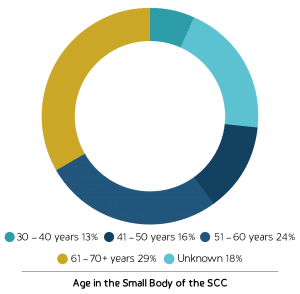
Age in the Small Body of the SCC
The average age of the SCC members in the Small Body of the regime block is 54 years, in the opposition it is 52 years and 57 years in the Middle Third. There are no members under the age of 30 and only seven members in the Small Body and ten in the Large Body who are between 30 and 40 years old. Moreover, 29% of SCC members in the Small Body are between 61 and 70+ years old. Thus, the voices, interests and the views of young people are not really represented. They are not involved in drafting the future constitution although they are a great part of society as the average age among the Syrian population is 21,4 years.
